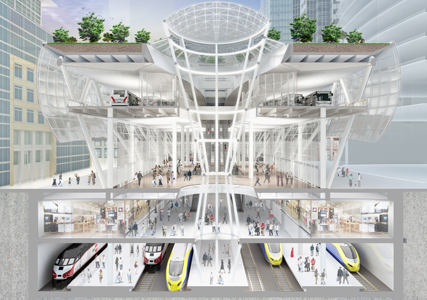The long-awaited “Grand Central Station of the West” is under way at last — after years of planning and accumulating funds, an international design competition, unrelenting political will from the Bay Area, Sacramento and Washington, DC, and a final boost of federal “stimulus” funds.

This cross section of the new terminal shows the bus deck on the top level and the underground train station serving both Caltrain and the California High-Speed Rail system. Image courtesy of Pelli Clarke Pelli Architects. Rendering courtesy of Transbay Joint Powers Authority.
By Marjorie Blackwell
Published: September, 2010
The $4.2 billion Transbay Transit Center in downtown San Francisco broke ground on August 11. When the new Center emerges on the site of the old Transbay Terminal in August 2017, it promises to launch a new era of urban transportation. It will link eight Bay Area counties with 11 bus and rail systems — in one modern, regional hub that will include an underground train station for future Caltrain and California high-speed train service. And that’s just the first phase.
Phase 2 funding will complete the Transit Center by extending underground rail tracks 1.3 miles from Caltrain’s current 4th and Townsend terminus, enabling the Center to fulfill its mission to bring Caltrain — and ultimately high-speed trains — to the heart of downtown.
In addition to vastly improving regional connections, the Transit Center will redefine living in downtown San Francisco by creating a brand new South of Market neighborhood with 2,600 housing units (35 percent below market), 3 million square feet of new commercial space, and the tallest office tower on the West Coast.
The Transit Center’s striking design is the work of Pelli Clarke Pelli Architects, which won the highly competitive design contest with its concept of an airy, five-story structure and a five-acre rooftop park that will provide welcome greenery and open space in the dense downtown. The Center’s ground floor concourse, with an entrance off of Mission Street, will feature a Grand Hall with a prominent light column bringing daylight into the building. Two levels up, the bus deck will house 30 bus bays with a direct connection to the Bay Bridge via aerial bus ramps. The bus deck will be used primarily by AC Transit, as well as by Muni buses serving Treasure Island, Westcat, Amtrak and Greyhound. Below ground will be two train levels; the train platform on the lower level will have six tracks for Caltrain and high-speed trains.
The rooftop park will feature a walking trail, gardens, lily ponds, an outdoor amphitheatre and retail shops. The park also will double as a “green roof” contributing to the transit facility’s environmental features.
In his remarks at the Transit Center’s groundbreaking ceremony, San Francisco Mayor Gavin Newsom extolled the prospect of linking jobs, housing and transit. “One of the things we’re celebrating, is the visionary leadership … that established a framework of transit first, that recognized the jobs-housing linkage, and that density with transit near and around jobs is our fate and future,” he said, adding that the project “is the ultimate manifestation of smart growth.”
The $4.2 billion Transbay Transit Center Project is being financed by various government agency partners: the federal government, the state of California, the Metropolitan Transportation Commission (MTC) and its Bay Area Toll Authority, the San Francisco County and San Mateo County Transportation Authorities, and AC Transit, among others. MTC has set aside over $350 million in bridge tolls for the project. Of this pot, $150 million is from Regional Measure 2 funds approved by Bay Area voters. The bridge toll funding is not only helping to finance the new terminal, but also financed construction of the temporary Transbay Terminal and demolition of the old Transbay Terminal.
The funding that put the Transit Center over the top and propelled it into construction was an infusion of $400 million in “stimulus” funds from the Obama Administration for the high-speed rail portion. Altogether, California has received $2.34 billion in federal funds for high-speed rail.
According to U.S. Secretary of Transportation Ray LaHood, speaking at the Transit Center groundbreaking ceremony, “California received the most high-speed rail money (in the nation) because you have your act together and have been working on high-speed rail for a decade.”
“California,” he said, “is way ahead of the curve when it comes to high-speed rail.”

A view of the Grand Hall, with its prominent light column bringing daylight into the building. Image courtesy of Pelli Clarke Pelli Architects. Rendering courtesy of Transbay Joint Powers Authority.

